(Updated June 2007)
Legend and Landscape
What becomes a legend most? Excellence? Scarcity? Expense? 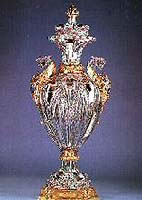 Good PR? Baccarat crystal, like DeBeers diamonds, has carefully cultivated the attributes of a legend for two and a half centuries–and with great success.
Good PR? Baccarat crystal, like DeBeers diamonds, has carefully cultivated the attributes of a legend for two and a half centuries–and with great success.
Asked to name the top few crystal makers in the world, the typical (upscale) shopper is likely to include Baccarat. Its beautifully executed lead crystal stemware and statuary have graced the finest salons and tables of haute monde throughout the world in a carefully controlled flow of superior craftsmanship and design.
As with most legends, too much reality can be a foil. The town of Baccarat, set in the rolling green hills of eastern France, fifty miles southwest of Strassbourg, is half-industrial and half-residential. It’zs a polite and charming town with the requisite meandering river flowing under an arched stone bridge that leads to an Old Catholic church.
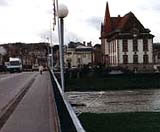 But the town is not part of the legend. It is sliced in half by the Mossel River. On one side are the quiet streets and shuttered stucco houses and little magazins for bread, meat and wine. They are functional and comfortable but do not command any artistic or architectural awe. It is a working class town of shopkeepers, stone masons, railway employees and, most notably, the ouvriers de crystallerie–the craftsmen and craftswomen who provide the stuff of the legend. Several highways intersect here bringing in and sending out daily truckloads of goods to the north to Saarebourg and south to Epinal. This is Alsace: busy, unpretentious and very proudly French.
But the town is not part of the legend. It is sliced in half by the Mossel River. On one side are the quiet streets and shuttered stucco houses and little magazins for bread, meat and wine. They are functional and comfortable but do not command any artistic or architectural awe. It is a working class town of shopkeepers, stone masons, railway employees and, most notably, the ouvriers de crystallerie–the craftsmen and craftswomen who provide the stuff of the legend. Several highways intersect here bringing in and sending out daily truckloads of goods to the north to Saarebourg and south to Epinal. This is Alsace: busy, unpretentious and very proudly French.
Inside the ‘Crystallerie’
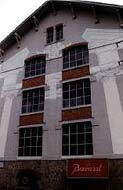 In 1764, King Louis XV granted the Bishop of Metz permission to establish a glassworks in Baccarat, France. Today, after four foreign invasions and three revolutions, the name still stands– Compagnie des Cristalleries de Baccarat.
In 1764, King Louis XV granted the Bishop of Metz permission to establish a glassworks in Baccarat, France. Today, after four foreign invasions and three revolutions, the name still stands– Compagnie des Cristalleries de Baccarat.
The name is housed in the great hulking brick fortress that houses the legend of Baccarat crystal. It is certainly not a legendary sight. It is a clearly a place of work however artistic the products may be. Inside, the labor is of sweaty men dressed in jeans pulling formless molten glass from fiery furnaces and pressing it into precious tableware or museum pieces.
Perhaps to sustain the legend–more probably for safety–there are no public tours available of the extensive glasswork factory that covers hundreds of acres. For the visitor or shopper, there are only two partial entrees into the workings of the company: the retail store of the crystallerie which backs up against the walls of the factory (no discounts, no seconds, no seasonal sales), and the picturesque old museum a few yards away from the store.
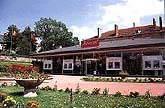
The first impact of the crystal store is visual–it is very bright, day and night. Crystal shows best under brilliant halogen lighting and this is where the legend comes alive. The store sparkles with the current assortment of Baccarat offerings: clear and colored goblets, tumblers, pitchers, cruets, dishes, vases, decanters, perfume bottles, candelabras and serving dishes.
There are also spectacular ornamental animal figures (horse heads, deer heads, owls, fish) that can absorb the entire limit on most credit cards. In one corner sits one of Baccarat’s crown pieces–a round glass top table, four feet in diameter, resting on three large crystal leaf-shaped legs. (If you can afford it, you don’t ask the price.) At night, the whole shop glows in white light illuminating the bustle of the main street.
Museum of Glass
The museum is housed in an elegant 19th century manor house that was once home to the managers of the crystallerie. It sits at the end of a long quiet courtyard lined with company-owned row houses, each with window shutters of a different hue, where factory workers have been housed for a century and a half.
For three dollars, 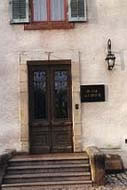 admission is gained to the museum and here is where the legend best shows itself in this town. The starting point is the ten-minute video that depicts the crystal making process from molten blob to prize statuary. It is the only view of the inside of the factory that most outsiders can get.
admission is gained to the museum and here is where the legend best shows itself in this town. The starting point is the ten-minute video that depicts the crystal making process from molten blob to prize statuary. It is the only view of the inside of the factory that most outsiders can get.
Some of the most remarkable images in the documentary are the choreographic movements of the teams of glassblowers and assistants as they lift a red glowing bulb of glass from the furnace, turning it to keep it from drooping. They swiftly dance through smooth motions to impress the glass with metal rods or wooden paddles as it is rotated and shaped on the glassmaker’s chair.
If the molten form is to be hollow inside, like a bottle or vase, it comes out of the furnace on the end of a blow-stick and placed into a mold where it is then inflated by a barrel-chested blower into its preliminary end-form. The balletic display of the craftsmen’s motions is clean, smooth and the result of decades of apprenticeship in this delicate work.
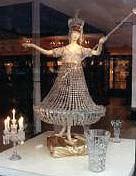 According to the other displays around the room, the ingredients in crystal glass are very basic: silica (55%), lead (32%–too much lead causes the glass to go green, too little and it looses brilliance upon cutting), and potassium (13%) are mixed with diverse chemicals (some for color) along with “groisil” (recycled crystal–imperfect pieces are melted down rather than sold–part of the legend).
According to the other displays around the room, the ingredients in crystal glass are very basic: silica (55%), lead (32%–too much lead causes the glass to go green, too little and it looses brilliance upon cutting), and potassium (13%) are mixed with diverse chemicals (some for color) along with “groisil” (recycled crystal–imperfect pieces are melted down rather than sold–part of the legend).
These are all baked at 1500 degrees for a calculated period of time and removed at just the right viscosity to allow for manageable and skillful shaping, which can take from two to several people. If coloration is desired, certain minerals are added for particular hues such as arsenic or iron (for yellow), cobalt (blue), nickel (violet), manganese (rose). Uranium (not harmful) is used to cast a blue-green tint.
Tools of the trade are also on display here. These are remarkably few and very traditional such as the spinning rods, clippers, shaping box, glassmaker’s chair with long metal arms for rotating the rod and glass bulb back and forth as it is hand shaped, along with various wooden and iron molds. They look like primitive child’s toys but in the hands of skilled artisans shaped over decades of training, they produce the wonders of Baccarat.
There are basically two stages to the creation of each piece of crystal–the hot work and the cold work. 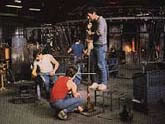 The mixing, melting and shaping–the hot work– is done at the furnace where the workers move in synch with each other to shape the glass into designs by turning, clipping, appending, pulling, curling or blowing the liquid into freeform sculpture. Or, by pouring the molten glass into preset molds (which we do not see in the video) all within a minute of birth from the fiery oven.
The mixing, melting and shaping–the hot work– is done at the furnace where the workers move in synch with each other to shape the glass into designs by turning, clipping, appending, pulling, curling or blowing the liquid into freeform sculpture. Or, by pouring the molten glass into preset molds (which we do not see in the video) all within a minute of birth from the fiery oven.
The cold work begins after the hot dance has given final shape and the crystal has been allowed to cool slowly. Cold work is more individual and meticulous, and equally as skilled as hot work. The crystal cutters have the discretion and steadiness and priceless ability equal to a diamond cutter.
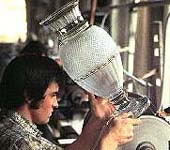 The cutting, frosting, or embossing of each goblet, figure or specialty piece are done one piece at a time holding the item against diamond-studded grinding stones that slice prism-shaped gouges into the crystal surface. There is no margin for error. The essential part of the legend of Baccarat is excellence so it’s not unusual for a cutter to have fifteen or twenty years’ experience at a wheel.
The cutting, frosting, or embossing of each goblet, figure or specialty piece are done one piece at a time holding the item against diamond-studded grinding stones that slice prism-shaped gouges into the crystal surface. There is no margin for error. The essential part of the legend of Baccarat is excellence so it’s not unusual for a cutter to have fifteen or twenty years’ experience at a wheel.
One intriguing display presents the sequence of work stages involved in creating a goblet step-by-step from hot blob to showcase item. A gold-embossed frosted water goblet can involve the work of 60 people from the point of design concept to the delivery at the showroom.
The Legend in History
Beyond the displays of the fabrication process, the museum offers several rooms full of the Baccarat’s artistic and historic glory. 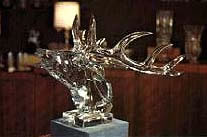 Here is the heart of the legend. Beautiful prize-winning crystal produced over the past two centuries sparkle and impress the eye. The skill and the imagination of the various elegant styles that have emerged over the decades have provided the world with great works of art and practical table pieces.
Here is the heart of the legend. Beautiful prize-winning crystal produced over the past two centuries sparkle and impress the eye. The skill and the imagination of the various elegant styles that have emerged over the decades have provided the world with great works of art and practical table pieces.
Legendary crystal for legendary people can be seen here. Kings, sultans, presidents, ambassadors and czars from all cultures have had their Baccarat place settings and stemware made in this town. Czar Nicholas II’s engraved and gold wineglass design appears next to the White House selection from Roosevelt and Whitehall’s choice from the Churchills.
Lining other walls are the floor-to-ceiling displays of priceless single creations from numerous limited editions over the decades. (Scarcity also enhances the legend.) A 1904 dragonfly, a deep cobalt-blue swan-shaped bowl in the art deco style, and the magnificent 1937 frosted panther designed by the esteemed Georges Chevelier are each 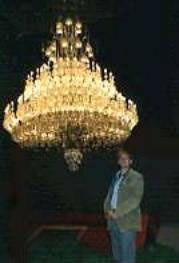 surrounded by other gracious and intricate masterpieces from the Baccarat artisans.
surrounded by other gracious and intricate masterpieces from the Baccarat artisans.
Occasionally the designers and glassmakers like to create spectacles of their work such as the seven-foot tall candelabra, consisting of a thousand pieces of crystal, made for the Universal Exposition in 1878. (photo right with Richard)
More recently, in 1994, another splurge of enthusiasm resulted in a giant chandelier fourteen feet high, ten feet in diameter with 230 lights to commemorate the 230th anniversary of the original founding of the Baccarat crystal works. This ‘lustre’ has 8,086 pieces of crystal and weights one and a half tons. It is big enough to be housed in its own display chapel across the path from the museum.
Necessities and Reality
If you like to keep your legends pure, perhaps it’s wise not to visit this brick and stone town. You can let the art speak for itself. But if you like the stuff of which legends are made such as the pulse of working artisans, the homey French houses trimmed with red geraniums, the smell of fresh baguettes, the pricey sport of French fine dining and the dazzle of first class crystal shops (there are half a dozen in the town)–then go and indulge in the culture and be dazzled by the luxury and light of the crystal city.
Since Baccarat town is not really a high tourist destination (more of a day shopping trip), there is not much preparation for tourists. There are a couple of comfortable small hotels, a handful of local yet tasty restaurants and a couple of dozen merchandise shops.
Otherwise, 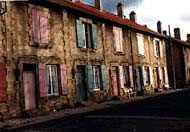 it is more rewarding to use the larger cities of Nancy or Strassbourg as a base. Both of these picturesque cities have far more historic and artistic attractions and are within an hour’s drive–but then again, don’t have the same kind of legend.
it is more rewarding to use the larger cities of Nancy or Strassbourg as a base. Both of these picturesque cities have far more historic and artistic attractions and are within an hour’s drive–but then again, don’t have the same kind of legend.
(photo left workers’ row homes built by the company
Also see:
Gay France Stories
Gay France News & Reports 2000 to present
Gay France Photo Galleries
















